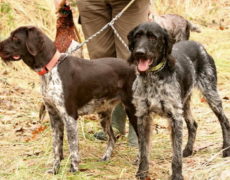Stichelhaar
The Stichelhaar is a medium-sized, griffon type dog breed that developed in Germany. Despite their striking looks and loyal disposition, they couldn’t be very much popular because of their biting tendencies. These canids have an elongated head with a broad muzzle and oval eyes, while their ears are floppy and set flat against the head. Their body and the slim legs are covered with semi-long hair, and their docked tail typically measures to two-fifths of the natural length.
Stichelhaar Pictures
- Deutsch Stichelhaar
- Deutscher Stichelhaariger Vorstehhund
- German Roughhaired Pointer
- Stichelhaar Dog
- Stichelhaar Images
- Stichelhaar Pictures
- Stichelhaar Puppies
- Stichelhaar
- Drahthaar
Quick Description
| Other Names/Nicknames | German Wirehaired Pointer, German Rough-haired Pointer, Deutsch Stichelhaar, Drahthaar, Deutscher, Drahthaariger, Deutscher Stichelhaariger Vorstehhund, Vorstehund |
| Coat | Double-layered, Long, Shaggy, Wavy, Curly, Dense |
| Colors | White, Black, Gray, Brown |
| Type | Watchdog, Sporting Dog |
| Group (of Breed) | Purebred |
| Lifespan | 12 to 14 years |
| Weight | 45-75 pounds (adult male/female) |
| Height (Size) | Medium; 22-26 inches |
| Litter Size | 6-10 puppies |
| Personality Traits | Loving, loyal, intelligent, active, protective |
| Good with Children | Yes (if grown up together; vigilance recommended) |
| Good with Pets | No (including cats) |
| Good for New/Novice Owners | Yes |
| Barking | High to very high |
| Shedding | Less |
| Drooling | Less |
| Chances of Obesity | Moderate |
| Biting Tendency | More than average |
| Hunting Tendency | High |
| Wandering Tendency | High |
| Hypoallergenic | No |
| Country of Origin | Germany |
| Competitive Registration/ Qualification Information | Recognized by: FCI Breed Standards |
History& Development
The Stichelhaar is the oldest German rough-haired Pointing Dog breed that originated in the early 1900s in Frankfurt, Germany. It developed from a cross between the German sheepdogs and rough-haired standing dogs. The breed got its first recognition from the FCI in August 1961, while the Breed Standards were published much later – in November 2001.
Temperament and Behavior
The Stichelhaars are known to be one-man dogs that are loyal and calm in general and are friendly and loving to those they know. They make good watchdogs, however, when it comes to strangers, they might at times become dominant or even aggressive, often displaying a tendency to bite. They are good and playful with children provided they grow up together. But they need to socialize to act friendly with other pets and dogs.
Care
Exercise
Needless to say, this overly energetic breed needs lots of exercise and activities. Go out for long walks or jogging, preferably twice a day, and allow it to burn out the excess calories by setting them free from the leash and play freely inside an enclosed area.
(It is advisable that you have a yard before you plan to bring this dog home.)
Grooming
The grooming requirement of the Strichelhaar is moderate. You need to brush its coat two to three times a week to retain the sheen and keep it free from dirt.
Health Problems
Except for a few minor reports of hip and follicular dysplasia, the Stichelhaar is otherwise a healthy breed.
Training
To ward off chances of your dog becoming infamous for its biting habits, begin from puppyhood. Firstly, make sure you effectively gain control over your dog teaching it the basic commands like Sit, Halt, Come back’ and Leave it, thoroughly. Engage your dog in games where it can get chances to interact, thus strengthening the dog-to-human bonding. However, refrain from competitive games like tug of war or wrestling. Also, keep your dog’s vaccination up-to-date.
Leash training is equally important. Get your pet acquainted to the leash at a tender age. Give a pat or a hug whenever it obeys you. Since it is a one-man dog, your pup would associate your appreciation with its leash and would readily agree to wear it at any time.
The Stichelhaar is more of an outdoor dog, but helping it learn to stay at home is also important. To socialize your puppy while still indoors, ask your friends to visit you from time to time. Ask them to give your pup a snack or two from your treat box. Your puppy would gradually begin to feel comfortable (and even friendly) with outsiders, and will learn to keep your guests out of its suspicious people’s list.
Diet/Feeding
2½ to 3 cups of high-quality dry dog food daily (like kibble) is enough for your Stichelhaar.















